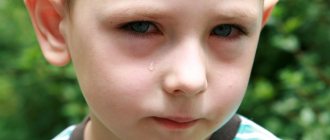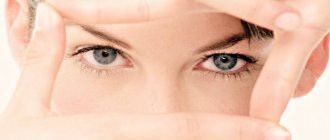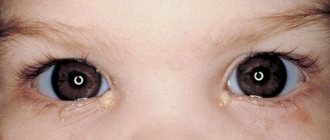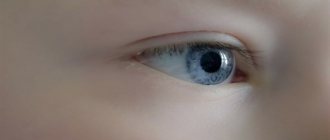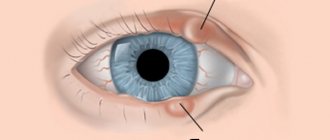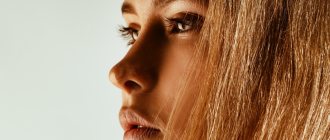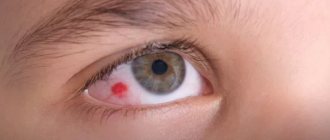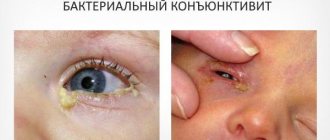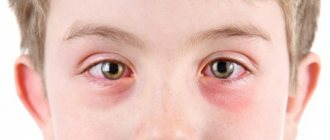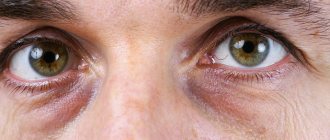Answer
In children, such symptoms occur all the time, and there are many reasons for the appearance of blisters. As for the blood test and dirty hands, the data is clearly not enough to make a diagnosis, especially taking into account the recurrence of the skin element.
In your case, it is worth contacting dermatologists again and pointing out the recurrence of the blister for a more thorough diagnosis and treatment.
Boils on the skin of the face
The blister may be a boil caused by an infection.
Boils appear when a skin defect becomes infected and are accompanied by the following symptoms:
- A small nodule appears, which gradually turns into an abscess (within 24-48 hours);
- An inflamed formation appears without clear boundaries;
- The temperature may rise, and the condition is sometimes accompanied by general weakness and headache.
All this is resolved by the discharge of pus. In a word, it was definitely not a boil, most likely we are talking about allergic reactions like urticaria.
Acute urticaria in children
A blister on the face due to hives is also possible
Appears suddenly, characterized by the rapid formation of a rash in the form of blisters of different sizes (the so-called urticarial rash). As a rule, blisters are round and rise above the skin. Along the edges of such formations there is a fuzzy pink border.
Sometimes this condition is accompanied by fever, indigestion and weakness, but in most cases everything is limited to skin manifestations.
Literally after a couple of hours, the blister disappears without a trace, unless the child tried to squeeze it out or puncture it, of course.
This condition occurs as a result of allergic reactions or (less commonly) mechanical irritation of the skin during dermographism (skin reaction to physical impact).
Excessive dermographism manifests itself as blisters without any itching or inflammation at all and is a neurogenic phenomenon.
Urticarial dermographism
Occurs in every twentieth child, i.e. not that rare. Develops due to increased sensitivity of the skin.
Very often, urticarial dermographism is associated with helminthiases and giardiasis, so it would be a good idea to check the child for ovuleworm and giardia.
Urticarial dermapraffism is easy to check - run your fingernail over your child's skin.
In many cases, exacerbations occur under severe stress - check with the girl if she was nervous these days (classmates, tests, etc.). Sometimes this type of skin reaction accompanies and is supported by dysbiosis and other digestive disorders.
This hypothesis can be tested simply: run your fingernail over the child’s skin. Normally, the mark and redness disappears after a few minutes. With urticaria, inflammation remains for a long time, and a scar may even appear when the nail is pressed hard.
It is pointless to treat the condition itself; most efforts are aimed at mitigating provoking factors: dysbacteriosis, parasitosis, diseases of the digestive system.
Contact dermatitis
Contact dermatitis can be caused by touching an allergen
The essence of the process is allergic reactions to some substrate that periodically comes into contact with the skin of the face. Contact dermatitis develops in areas that can be reached with your hands or that are in direct contact with the allergen.
As a result of local inflammation, a blister is formed, i.e. The nature of the process is not infectious, but allergic. The girl's second blister appeared on a different area of her skin, which is consistent with this version.
One can only guess what exactly caused the blister to appear during the lesson. Try asking your daughter what she did (hold it in her hands, pass it to her neighbors, etc.) before the blister appeared in the first and subsequent episodes.
To determine the allergen and confirm contact or atopic dermatitis, skin tests must be done. The procedure is painless - the skin's reaction to various typical allergens is studied.
There may not be a pronounced inflammatory reaction with contact dermatitis, especially since a general blood test is not a highly accurate diagnostic method.
Atopic dermatitis
Atopic dermatitis rashes are the result of a reaction to food
This term refers primarily to allergic reactions to foods and their components. In some cases, food allergies may manifest themselves in the manner you indicated. The allergen is determined in a similar way, after which products containing the provoking substance are removed from the diet.
For 2 weeks after diagnosis of atopic dermatitis, a hypoallergenic diet may be indicated. This is done to reduce the body’s reactivity, in order to prevent chronic inflammatory phenomena, for example, eczema.
Redness and blisters on a child's skin: diagnosis and treatment
Blisters or vesicles on a child's skin should alert parents. Rashes can be a symptom of a dangerous disease that requires immediate medical attention. What causes such formations on the skin and what kind of diagnosis and treatment is required, read the article.
Possible causes
Blisters are a type of rash in the form of compacted, round or irregularly shaped elements protruding above the surface of the skin. They are distinguished from bubbles by the absence of an internal cavity with any contents. Blisters are characterized by accompanying burning and itching, appear quickly and disappear within a short time.
The development of these elements is caused by acute inflammation and swelling of the papillary layer of the skin, and is often an allergic reaction to an external or internal irritant.
There are several possible reasons why blisters or blisters appear on your baby's skin. Some of them do not pose a danger and do not require specific treatment, others may signal a threat to the life and health of the child. Below we briefly describe the main reasons for the appearance of rashes of this kind:
- Hives. The appearance of blisters is the main symptom of urticaria . The name of this allergic reaction is due to the visual similarity of external manifestations with a nettle burn. Dense pink plaques protruding above the surface of the skin (they turn pale when pressed or scratched) are accompanied by severe itching, sometimes pain or burning. The edges of the seal are usually a brighter color than the center. You can see what urticaria looks like in the photo below:
The mechanisms of urticaria are not fully understood. It is known that consumption of a certain product (citrus fruits, red fish, chocolate, eggs) or medication can trigger the appearance of rashes.
https://www.youtube.com/watch?v=_teSBZdbze0
The appearance of symptoms is possible in people of any age, even in newborns, if the nursing mother violates the diet or uses an inappropriate formula.
- Insect bites. The affected areas of the epidermis swell, turn red, and itch very much.
- Reaction to sunlight. Formations protruding above the surface of the skin, with or without contents, can be caused by sunburn if the baby was not protected with special cream and clothing . In addition, some people react to ultraviolet light by developing red blisters even after short-term exposure. Later, the rashes may either disappear or turn into blisters with clear liquid inside, which then burst and heal.
- Chafing or pressure. Damage to children's skin can occur due to mechanical irritation, tight clothing or shoes (so-called calluses).
- Reaction to cold or heat. The formation of blisters or blisters may be caused by a thermal or chemical burn. Occasionally, a skin reaction such as urticaria occurs upon contact with hot or cold objects.
- Phytodermatitis. Toxic juice or stinging cells of some plants (nettle, hogweed), when they get on a child’s skin, provoke the appearance of edematous or cavitary formations. Phytoburns are accompanied by redness, severe itching and burning.
- Pemphigus. An autoimmune disease that has not been fully studied. Manifests itself in the form of bubble-like rashes on the skin and mucous membranes.
- Infection. A number of diseases caused by bacteria, fungus, viruses or parasites are accompanied by the appearance of red spots with blisters on children's skin (chickenpox, shingles and others).
- The neurogenic nature of skin formations is possible. In addition, they can be triggered by hormonal or metabolic imbalances.
- Lack of vitamins in children sometimes manifests itself in the form of blistering formations on the palms of the hands.
The appearance and location of the blisters on the body can suggest why they appeared. But if the reasons are not obvious, you should consult a doctor for a more accurate diagnosis and prescribe therapy if necessary. The appearance of blisters on the skin of a newborn is especially dangerous, since his body is not yet able to effectively resist dangerous diseases.
Symptoms
To better understand what exactly causes blisters or blisters in a child, you should pay attention to the accompanying symptoms.
A sign indicating a dangerous condition requiring treatment is the spread of rashes over the entire surface of the body. May be caused by an infectious disease, pemphigus or urticaria.
Urticaria is very dangerous, since swelling can occur not only on the surface of the skin, but also on the mucous membranes. In some cases, Quincke's edema (in the larynx) rapidly develops, which can lead to death from suffocation (asphyxia).
In most cases, the appearance of cavitary or non-cavitary formations on the surface of the skin is accompanied by redness and severe itching (the exceptions are thermal, chemical and sunburns, calluses - they are accompanied by pain).
Infectious diseases spread quickly, affecting organs and tissues. If treatment is not started on time, severe complications may develop. Often accompanying symptoms are fever, general malaise and weakness. This may indicate both an allergic and infectious nature of the disease. The presence of infection is indicated by the following symptoms:
- diarrhea,
- vomit,
- heat.
If a bloody or dark spot is visible in the middle of the blister, it can be assumed that the cause is an insect bite.
When seeking help from a doctor, it is necessary to describe in as much detail as possible all the existing symptoms, as well as factors and situations that could affect the child’s condition (use of any unusual product, possible contact with chemicals, being in the forest, in a village or in a large group of children and other).
Diagnostics
For a correct diagnosis, an examination is sometimes enough for a specialist. Based on the appearance and location of skin formations, as well as based on known additional symptoms, the doctor will determine the cause of the rash and give recommendations for treatment.
If the nature of the disease is not entirely clear, they resort to differential diagnosis. This method requires a careful comparison of all available symptoms to identify the only correct diagnosis.
In some cases, additional tests may be required:
- general or clinical blood test,
- test for antibodies to pathogens of infectious diseases or immunoglobulin E (if an allergic reaction is suspected).
- bubble content analysis,
If there are signs of fungal infection, inspection using special equipment (Wood's lamp) will be required.
Self-diagnosis and treatment are dangerous, since the child’s fragile body may not be able to cope with the disease. In some cases, severe complications and even death may occur. The exception is situations when the causes of blisters are precisely known and do not pose a danger (calluses, nettle burn).
Treatment
Therapeutic methods depend on the nature of the rash and the cause that caused it. If skin lesions are caused by an infectious or allergic disease, you should abandon the idea of treating them with folk remedies. Classic therapy under the supervision of a doctor is safer for the child.
Traditional methods
Medicine has reliable and well-proven methods for treating blisters of any etiology.
If the cause of the rash is urticaria, treatment is primarily aimed at suppressing allergies. To quickly relieve swelling and prevent asphyxia, they sometimes resort to injections of antihistamines (for example, Tavegil).
The child must:
- follow a hypoallergenic diet,
- take enterosorbents to cleanse the body (activated carbon, Enterosgel, Polyphepan),
- if an attack of hives is caused by a medicine, stop using it,
- undergo a course of treatment with a prescribed antihistamine (in drops or tablets - Zodak, Fenistil, Zyrtec, Erius).
These measures are enough to stop an acute attack of urticaria and avoid relapses.
Important! If you interrupt treatment and break your diet soon after the symptoms disappear, there is a very high risk of a second attack!
If the cause of skin formations is an infectious disease, the doctor will prescribe appropriate treatment:
- antibiotic, antiviral or fungicidal (antifungal) drug depending on the causative agent of the disease,
- quarantine,
- external agent for antiseptic treatment and relieving itching,
- diet,
- antihistamines to reduce itching (not always, at the discretion of the doctor),
- antipyretic and anti-inflammatory drugs if necessary (ibuprofen, paracetamol),
It is advisable to treat infectious diseases in children in a hospital setting. In this case, the attending physician will be able to constantly monitor the patient’s condition and quickly provide assistance in case of complications (with the exception of chickenpox).
ethnoscience
It is permissible to independently treat irritations on a child’s body if they occupy a small area and are caused by relatively harmless reasons, such as:
- nettle burn,
- a bite of an insect,
- minor thermal or sunburn,
- rubbing clothes or shoes.
Blisters with watery contents should not be opened to avoid infection. The goal is to prevent damage and infection and promote healing of the skin.
First of all, use cold water or compresses to relieve pain and itching. For small burn blisters and calluses, it is recommended:
- lubricate them with sea buckthorn oil or goose fat to speed up healing,
- apply a cut aloe leaf, hold for 30 minutes,
- mix heated vegetable oil with propolis (200x30 g), cool, lubricate the damaged area with the composition, cover with a bandage,
- apply a paste of finely grated vegetables - potatoes or carrots - to speed up healing.
If the bubble has opened, the wound must be treated with an antiseptic (hydrogen peroxide, furatsilin solution), and covered with a sterile bandage.
It is recommended to treat insect bites with lavender or tea tree essential oil. They will relieve inflammation and accelerate tissue healing.
Causes of blisters on and under the eye
What disease does a blister on the eye indicate? A blister may be the cause of a person having the herpes virus. According to scientists, the majority of people on the planet are infected with this disease.
The virus can manifest itself not only in the eye area, but also in other parts of the body. Herpes is small blisters filled with fluid. In front of the eyes, this disease occurs with severe itching and slight tingling.
This video will tell you who to contact if you have blisters on your eyes:
In some cases, body temperature rises. Causes of herpes:
- stressful situations and constant worries;
- constant use of antibiotics;
- severe hypothermia.
Important! The herpes virus is a rather serious disease that requires timely treatment. Otherwise, it may spread to other parts of the body.
Bubbles may be symptoms of an allergic reaction. Blisters most often occur when using cosmetics.
Very often the cause of blisters is a Mohl cyst. This disease is associated with dysfunction of the sweat glands. In this case, you should not seek treatment. The disease may go away on its own within a few days.
Blisters can be caused by insect bites.
How to treat such blisters with medication
Blisters that appear near the eyes can be treated in two common ways: traditional medicine and pharmaceuticals.
Traditional medicine treatment methods:
- acyclovir is a drug that actively fights the herpes virus. There are also other drugs that fight herpes no less effectively: cycloferon, amixin, foscarnet. In addition to drug treatment, it is necessary to protect yourself from excessive physical activity and constant stress;
- Antihistamines will help treat allergies. The most well-known and accessible medications include the following drugs: opatanol, levocabastine, azelastine, olopatadine;
- papillomas are treated with laser. This method is completely painless. Before the procedure begins, the affected area of skin is pre-frozen;
- A Mohl cyst does not need to be treated; it goes away on its own after a certain amount of time. There are cases when the cyst reaches enormous sizes, then the person will need to get a puncture.
Traditional methods of treating the disease
Folk remedies are mainly used not to eliminate blisters, but to relieve itching and swelling. It is better not to touch a blister formed on the upper part of the eyelid with your hands. Ways to eliminate itching:
- use of lotions with menthol, anesthetic and novocaine solutions. To prepare a compress, you will need one of the presented products and a cotton swab.
Important! Self-treatment of diseases with folk remedies can lead to negative consequences.
You should not start self-medicating with various self-made cauterizing ointments. This way you can only make the situation worse.
How to avoid their reappearance
Any disease can be treated, but it can recur at certain intervals. To prevent this from happening, precautions should be taken:
- avoid strong drafts and hypothermia;
- strengthen the immune system;
- carefully select cosmetics;
- observe the rules of personal hygiene.
Despite the large number of folk remedies. When treating the disease, preference should be given to proven medications.
Causes of blisters around the eyes of a child
Thin and dry skin near the eyes is particularly sensitive and reacts strongly to any negative influence from the outside. A rash may indicate problems with certain organs and systems of the body, and may also indicate an allergic reaction. First, it is important to determine the main causes of rashes under the eyes of a child.
Main types of rashes
A rash in the eyelid area and under the eyes can be of the following types:
- small pimples;
- blisters with watery contents;
- pronounced spots;
- nodules.
Depending on the cause of the rash around the child’s eyes, the formation changes its color, and the skin in the affected area becomes very inflamed. Small rashes under the eyes of a child can be nodules or blisters with watery contents. A photo of a rash under the eyes of a child is presented below.
The blistering rash on the eyes spreads mainly over the thin skin of the eyelids. In this case, the contents of the bubbles are colorless and easily come out even with minimal trauma to the formation. A nodular rash is characterized by the formation of small lumps under the skin. It is pink in color, and the skin may become very inflamed and swollen between rashes.
Small ulcers may appear on the skin of the eyes. In appearance, they are similar to blistering rashes, but their contents are white or yellow. Skin irritation in this area leads to the appearance of a red rash under the child's eyes.
Factors in the appearance of formations
The main causes of a rash around the eyes in a child include:
- allergic reactions;
- dermatological diseases;
- fungal infection;
- entry of bacteria.
Also, rashes under the eyes in childhood can appear due to lack of sleep or recent stress, nervous experiences and emotional shock.
Often a red rash around a child's eyes occurs due to allergies. In this case, the allergen can be various items: food, as well as cosmetics and skin care products.
With the development of mycosis (fungal infection), red spots form on the thin skin of the eyes. They can be uncomfortable, itchy and itchy. A bacterial infection of the delicate skin near the eyes causes a pustular rash. This dermatological lesion is characterized by an inflammatory process in the affected area.
Rash near the eyes of a baby
Rashes under the eyes of a newborn baby can appear as a result of dermatitis, an allergic reaction to a certain external irritant.
The atopic form of dermatitis in a child resolves against the background of the appearance of small inflamed spots on the skin. Such rashes are localized mainly in the eye area. Atopic dermatitis often appears when the air in a child’s bedroom is too dry. In this case, signs of irritation first appear on the delicate skin of the eyes. A photo of a rash around a child’s eyes can be seen below.
With contact dermatitis, along with a small rash under the eyes, the child begins to experience severe peeling of the skin. Such inflammation can occur as a result of contact with synthetic fabrics.
Exposure to irritants
An allergic reaction on a child’s skin can begin as a result of the following irritants:
- food allergies;
- cosmetic products or household detergents;
- plant pollen, dust;
- animal fur.
The first signs of an allergic reaction usually appear on the face, including the eye area. In this case, treatment of the rash begins with identifying the main irritant.
A small rash around the eyes of a child may occur in response to irritation of thin and sensitive skin. This often happens when a child rubs his skin on bedding. Another common cause of this condition is inflammation of the skin near the eyes, which begins when shampoo accidentally gets into the eyes while swimming.
Rash as you get older
A rash under the eyes of an older child may be caused by an allergic reaction or bacteria. Allergies manifest themselves in the formation of small red rashes on the surface of the skin.
In this case, a person may experience an inflammatory process on the skin and characteristic swelling may appear. The allergy goes away against the background of an unpleasant burning and itching of the skin.
If a parent can identify the allergen in time and eliminate its effect on the child’s body, then this type of rash can go away on its own, without the use of any medications.
Source: https://geraklionmed.ru/voldyri-vokrug-glaz-u-rebenka-prichiny/
What not to do with such blisters
If a blister occurs in the corner of the eye, the following important rules should be followed:
- You should not scratch the blister inside the eye, because such actions can damage the skin and cause a serious infection;
- It is recommended to avoid drafts and cool rooms;
- You should protect yourself from getting dust and dirt on your skin;
- it is necessary to protect affected areas from water;
- avoid stuffy rooms;
- If traditional medicine does not give a positive result, then you can turn to drug treatment.
If you follow all the recommendations, the disease will recede quite quickly.
First aid for blisters in the corner of the eye
When a disease is detected, the patient is advised to first determine what disease he is dealing with. Afterwards, it is recommended to immediately provide first aid, which will become the initial platform for further treatment of the disease.
When outdoors, it is recommended to cover the affected areas with adhesive tape, this way the likelihood of dirt getting into your eyes will be reduced several times.
Important! If dirt gets into the eye, you should immediately rinse the eye with clean warm water. It is recommended to do everything very carefully so as not to damage the blister.
How to care for blisters on the upper eyelid
Each person chooses their own method of caring for emerging blisters. For care, expensive medications or the most common traditional medicine can be chosen.
It is recommended to rinse your eyes with purified water daily.
To reduce swelling of the eyes, apply a decoction of herbs or seaweed to the affected area.
Should you scratch blisters or not?
Blisters that appear in the eye area are often accompanied by severe itching. In this case, many people ask the question: is it possible to scratch them? The answer is quite simple - you can’t.
Scratching the affected area can lead not only to the spread of the disease, but also to an increase in the affected areas and to slower healing.
What are white blisters that appear on the eye, watch in this video:
How to treat blisters on the eyes?
We do not recommend treating blisters on the eyelids and eyes on your own; consult an ophthalmologist. It may be necessary to consult an endocrinologist, therapist, and otolaryngologist. It all depends on the reasons for the appearance of bubbles. Depending on the disease, the treatment method is chosen.
Review of treatment methods and drugs:
- If the blister is caused by a herpes virus, Acyclovir is most often prescribed. This is an ointment that will lubricate the mucous membrane. They may also prescribe antiviral drops, such as Poludan or antibiotics, to prevent a bacterial infection.
- A Moll cyst goes away on its own within 10 days. If this does not happen, and it has increased in size, the doctor makes a puncture to extract the contents of the vesicle.
- Formations that arise as a result of exposure to the papilloma virus do not go away on their own; they must be removed using a laser or freezing. Now in many clinics there are devices with which such tumors are removed. The manipulation is practically painless and the burn site heals very quickly, without causing any pain or side effects.
- If the blisters are caused by an allergy due to the use of a new cosmetic product, it is necessary to undergo a course of treatment with antihistamines. Diazolin, Loratadine or Cetrin are prescribed. Artificial tear drops may also be prescribed in order to restore lavage to the eye and prevent the mucous membrane from drying out.
Stye
If a transparent bubble appears on the eye, you should not hesitate to visit a doctor, nor should you self-medicate. It's time to go to an ophthalmologist or ophthalmologist, and if necessary, additionally consult with an ENT doctor, therapist, or endocrinologist. There are many medications that help eliminate the causes of blisters. Medicines are prescribed depending on the cause of the disease:
- Treatment of herpes involves the use of local and general medications. The doctor may prescribe Acyclovir ointment for external treatment of the eyelid, drops (Poludan, Oftalmoferon, Aktipol), immunomodulators for oral administration. An antiherpetic vaccine is often included in the course of treatment for herpes conjunctivitis.
- If you have allergies, it is recommended to take a course of antihistamines (Diazolin, Suprastin, Claridol, Trexil). Be sure to eliminate the allergen - replace cosmetics, adjust the diet.
- A Moll cyst goes away on its own within 5-10 days after its appearance, but there are cases when the blisters reach too large a size. In such situations, the doctor will make a careful puncture and remove the accumulation of secretions.
- Dense blisters that appear as a result of activation of the papillomavirus are removed by surgery or laser.
Folk remedies
With the approval of a doctor, blisters can be treated using traditional medicine, but this should be done with extreme caution, avoiding contact of caustic concentrates with the mucous membrane of the eye. Effective folk methods against papillomas are:
- Rowan juice, which is obtained by squeezing ripe fruits. The liquid must be applied to the surface of the bubbles in the morning and evening for two weeks. To prevent relapses, rowan juice can also be used to treat adjacent areas of healthy skin.
- To soften and remove papillomas, traditional healers recommend using aloe. This plant has strong anti-inflammatory properties. A piece of leaf with pulp must be glued to the bottle with a plaster; the leaf is first cleaned of the top rough film. The compress should be applied at night for one to two weeks. For treatment to be effective, it is recommended to use a plant that is at least two years old.
- Banana peel is another effective remedy that has recently received popular love. It is necessary to treat the bubbles until they disappear completely in the morning and before bed.
In case of allergies, along with taking antihistamines, it is recommended to treat the eyes with a decoction of oatmeal, and instill chamomile infusion into the eyelids. Popular recipes:
- Pour a glass of boiling water over one teaspoon of dry chamomile inflorescences. Let it brew for 20-30 minutes, then strain through several layers of gauze. Place the cooled broth in each eye, 2-3 drops three times a day until the unpleasant symptoms completely disappear.
- To relieve the inflammatory process, you can wipe your eyes with the same infusion using a cotton pad or make lotions. It is better to do the procedures in the morning and evening throughout the entire course of drug treatment.
- Take one glass of seeded oats or small oatmeal, pour into a thermos. Pour five cups of boiling water over the cereal and leave for 4-5 hours. Then drain half of the resulting liquid, and cook jelly from the remaining part. Take one glass of the drink in the morning on an empty stomach for a month.
Traditional medicine is rich in recipes that help treat herpes blisters on the eyes, but they can only be used after additional consultation with an ophthalmologist. To eliminate allergic blisters, you can brew medicinal herbs:
- Take 2 teaspoons of dry lungwort. Pour two cups of boiling water. Leave for 2 and a half hours. Strain the cooled solution. Rinse the affected area of the eyelid with it up to 6 times a day for two weeks.
- Take 1 tablespoon of dried arnica flowers. Pour a glass of boiling water over the herb. Leave for 3 hours. Treat the infected area of the eyelid with the prepared liquid every two hours until the symptoms completely disappear.
Causes of blisters on the eye
Blister on the eye - what is it? This is a blister that may indicate the presence of herpes.
Many scientists believe that this virus has infected most people on Earth. This disease feels great not only in the eye area, but throughout the human body. Herpes appears as small blisters filled with fluid.
In front of the eyes, this disease is accompanied by severe itching and mild tingling. In some cases, the temperature rises.
The causes of herpes can be the following factors:
- stress and anxiety;
- long-term use of antibiotics;
- hypothermia.
In addition to herpes, people often experience another viral disease - Papiloma. With this virus, growths appear on the skin, which can only be removed with a laser in specialized medical institutions.
Often, blisters around the eyes are symptoms of allergies. Most often, allergies occur in people who use cosmetics. As a rule, the allergy goes away quickly and no treatment is required; you just need to refrain from using cosmetics for a few days.
People often mistake a Mole Cyst for an allergy. This disease is associated with disruption of the sweat glands. It does not require treatment and goes away on its own within a few days.
What it might look like
Blisters on the mucous membrane of the eye or on the eyelids look like rounded, convex formations; they can be watery, white, or filled with purulent exudate. The location of a bubble or several can be anywhere: along the edge of the eyelashes, under the eyebrow, on the eyelids, on the mucous membrane or even on the cornea. The photo shows what such formations look like.
In this case, other accompanying symptoms often occur:
- itching and burning;
- redness;
- lacrimation;
- visual impairment;
- increase in body temperature.
Under no circumstances should you try to remove bubbles around the eyes yourself, try to squeeze them out, pierce them or burn them with an alcohol solution. Such blisters often indicate the development of a serious infection; self-medication can lead to its spread and deterioration of well-being.
By the location of the bubbles - on the eyelid, inside the eyelid, on the white of the eye - it is often possible to determine what caused its appearance
First aid
In almost all cases of blisters in the eye area, the success of treatment depends on correctly provided first aid.
First of all, you need to wash off the makeup from your face.
To prevent infection, the edges of the formation should be smeared with antibacterial ointment; if this is not available, then use any available antiseptic.
If you are outside, try to avoid getting dust and dirt on the blister; this can be done with an adhesive plaster.
Why do bubbles appear on the eyes?
The greatest concern arises when a transparent blister appears on the mucous membrane of the eye. This is true, because such symptoms can be caused by a very serious illness, as well as infection by some kind of virus. This may reduce visual acuity.
Causes of bubbles on the eyeball:
- Herpes virus. This virus can sleep in the body for a long time and not manifest itself in any way, but when immunity decreases, similar bubbles appear. They can be either in the corner of the eye or directly on the eyeball. They cause pain and can cause decreased vision for a certain period of time, until the mucous membrane is completely restored.
- Conjunctivitis. There is adenoviral conjunctivitis, which occurs after pharyngitis as a complication. Because of this, bubbles appear on the mucous membrane. They can be either barely noticeable or larger in size. They are clots of infiltrate. It is quite difficult to treat.
- Cyst. Often occurs after eye injury or infection with the herpes virus or adenovirus. They often resolve on their own, but most often require surgical intervention. If the cyst is small in size and does not cause any discomfort, while vision is preserved and there is no sensation of a foreign body, then surgical treatment is not necessary. Conservative therapy is carried out. If the cyst interferes with blinking and photophobia occurs, then surgical intervention is necessary.
Blisters on the eyelids
Small transparent blisters can appear both on the skin of the eyelids and directly on the mucous membrane of the eye. Localization of bubbles on the delicate mucous membrane of the eye will cause much more discomfort and concern.
Ocular herpes and its treatment
- colds or viral diseases. The formation of blisters and styes on the inner eyelid is a consequence of decreased immunity;
- hormonal imbalances - often bubbles appear in adolescents during puberty, or in women during pregnancy or with the onset of menopause;
- manifestations of the papilloma virus. In this case, characteristic jagged growths appear on the lower or upper eyelid.
It is obvious that rashes on the eyelids in themselves are not a disease, but only a manifestation of some pathology; the cause should be sought in internal disorders. There are also a number of provoking factors that may cause blisters to appear on the eyelids, these include:
- hypothermia;
- stress;
- decreased immunity;
- reaction to long-term use of any medications.
Below are some of the most common conditions that may cause blisters to appear on the eyelids or eyeball.
If a small blistering rash appears after changing cosmetics, most likely this is an allergic reaction to the inappropriate composition of mascara or pencil
Treatment options
Pharmacy methods
In modern medicine, there are a lot of drugs that can cure this disease, but first you need to find out the cause of the blisters.
- Acyclovir tablets and ointment are excellent for herpes. In addition to drug treatment, you should remember that external factors also play an important role. You should not expose your body to hypothermia, stress and prolonged physical activity.
- Try to be in the fresh air more often, eat right, and strengthen your immune system.
- In order to say goodbye to allergies, eliminate contact with the allergen: change the brand of cosmetics or give up cosmetics altogether for a while.
- Mohl cysts go away on their own. In a rare case, when the cyst has become impressive in size, you will need a puncture, which is performed by a specialist.
- Papilomas are more difficult to fight; you can only get rid of them from a doctor. Papilloma removal occurs using a laser. The procedure is completely painless, since the affected area is frozen before it.
Folk remedies
Traditional methods of treating blisters under the eyes are more aimed at eliminating unpleasant sensations, such as itching and swelling of the eyelids.
Perhaps the most common method in Russia for treating inflammatory processes in the eyes is a tea compress.
To prepare it, we need to pour two teaspoons of black tea into a glass of boiling water, then cover the glass with the tea solution with gauze to prevent dust from getting into the glass.
After the solution has cooled, moisten two cotton pads with it and carefully apply it to the eyelids.
A decoction of chamomile also helps with herpes.
Prevention
The following will help to avoid the re-formation of blisters on the eyelids:
- Maintaining immunity. Exercise, eat fruits and vegetables daily, and treat colds promptly.
- Eye hygiene. Do not touch your eyelids with unwashed hands, use only high-quality cosmetics, and properly care for your lenses.
- Elimination of allergens.
- Limiting visits to crowded places during outbreaks of viral infections.
In some cases, blistering rashes on the eyelids go away on their own without causing negative consequences. In any case, it is recommended to consult a specialist. If a rash occurs in a child, then a visit to the doctor is mandatory.
Share the article on social networks. Tell us about your experience in the comments. Be healthy. All the best.
What should you not do?
If you have a blister in the corner of your eye, you should remember a few rules:
- Under no circumstances should you scratch a blister in your eye, as this can further damage the skin and cause infection.
- Avoid drafts and cool rooms.
- The place where the blister is located should be protected from dust and dirt.
- Do not wet the affected area. There may be an infection in the water.
- Try not to be in stuffy, unventilated rooms.
- If traditional medicine does not give the desired effect, do not neglect traditional methods of treatment.
By following these simple rules, the disease will quickly recede.
Additional reasons
Additional reasons why a child may develop a rash include:
- the body's reaction to the vaccine;
- skin reaction to latex, from which many pacifiers are made;
- if hygiene rules are not followed - wiping your mouth with dirty hands;
- a rash can occur if a child licks his lips and the area near his mouth too often, especially if he has particularly sensitive skin;
- the skin around the mouth may become red as a result of exposure to low temperatures or chapping;
- If the baby’s body temperature rises sharply and rashes appear near the oral cavity, this may indicate the onset of an infectious process in the body, in which case it is important to immediately consult a doctor.
To avoid the appearance of unpleasant symptoms, it is important to accustom the child to the rules of personal hygiene from early childhood, carefully monitor his diet, and prevent the development of diarrhea or prolonged constipation. You should also conduct regular checks for the presence of worms in the body and visit your doctor.
source
